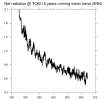Ting-Hui Lee
New Member
Hi,
I'm running B_2000_CAM5 with CESM1.2.2. It should be a warm start with all initial data except for the "finidat" in CLM. The initial net radiation at TOM (FSNT-FLNT) is about 1.45W/m2, and it decreased to 0.6 W/m2 at about year 140. Then it fluctuated at around 0.5 W/m2.
I used its restart file at year 140 and make a branch run with doubling CO2 concentration. The initial net radiation at TOM jumped to 2.1 W/m2 because of the CO2 (attached figure). In this branch experiment, it took more than 400 years for the net radiation to decrease to about 0.6 W/m2. But, it didn't fluctuate here. Instead, it's still decreasing by about 0.1 W/m2 per centenary from year 500-600. My question is can the output data (year 0500-0600) be used for analysis when the net radiation at TOM has a slight decrease? Or do I need to keep running this model until it reaches equilibrium so I can analyze its output data? How long does it usually take? And in which condition I can tell the branch experiment reaches equilibrium (net radiation at TOM fluctuates at 0 W/m2)?
Thank you.
I'm running B_2000_CAM5 with CESM1.2.2. It should be a warm start with all initial data except for the "finidat" in CLM. The initial net radiation at TOM (FSNT-FLNT) is about 1.45W/m2, and it decreased to 0.6 W/m2 at about year 140. Then it fluctuated at around 0.5 W/m2.
I used its restart file at year 140 and make a branch run with doubling CO2 concentration. The initial net radiation at TOM jumped to 2.1 W/m2 because of the CO2 (attached figure). In this branch experiment, it took more than 400 years for the net radiation to decrease to about 0.6 W/m2. But, it didn't fluctuate here. Instead, it's still decreasing by about 0.1 W/m2 per centenary from year 500-600. My question is can the output data (year 0500-0600) be used for analysis when the net radiation at TOM has a slight decrease? Or do I need to keep running this model until it reaches equilibrium so I can analyze its output data? How long does it usually take? And in which condition I can tell the branch experiment reaches equilibrium (net radiation at TOM fluctuates at 0 W/m2)?
Thank you.

